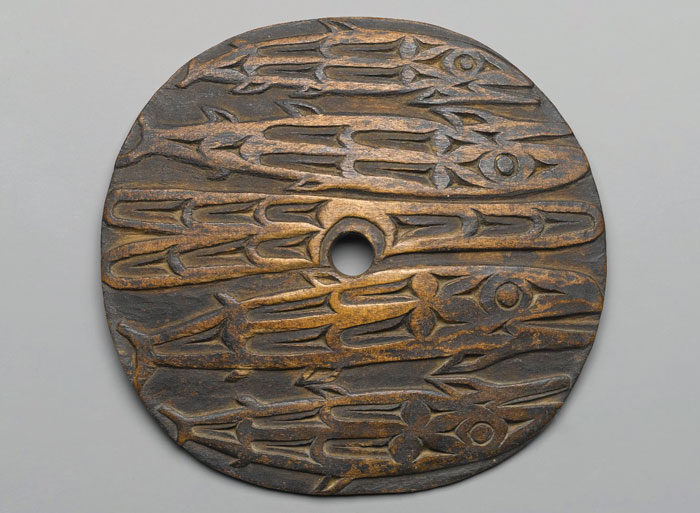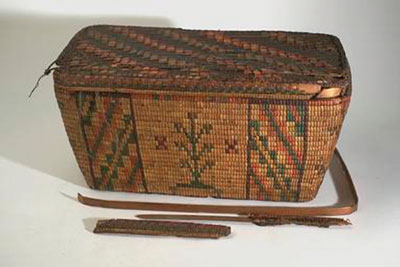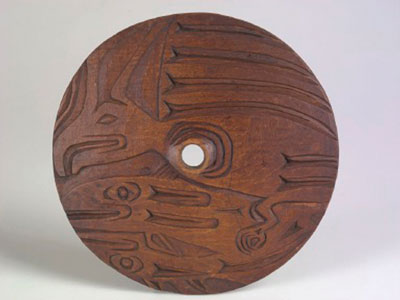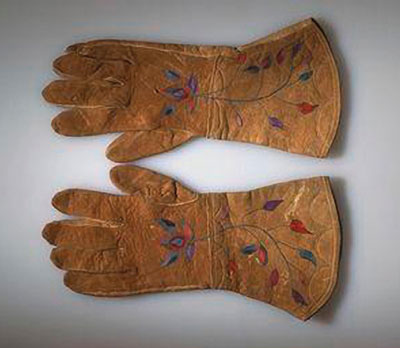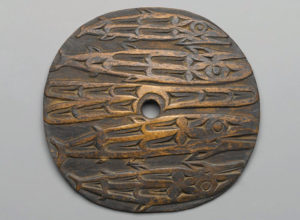A look at Salish belongings in NYC museum collections
By Anni Irish
Salish belongings have come to inhabit a unique space within North America and beyond. Various Indigenous objects such as carvings, blankets, spindle whorls and regalia were taken or sold away from communities after colonization, and many have now found their way into major museum collections.
The acquisition of Salish art and other Indigenous belongings into museum collections has a complicated history, because many Indigenous people are now disconnected from their ancestors’ belongings and cultural practices. Often, not much is known about where the objects originally came from. However museums have played a role in helping to preserve and interpret the works for future generations and for them be seen on a bigger scale.
New York City is home to many world class museums and cultural institutions. Recently, The Sentinel took a look at some of the Salish belongings that are sitting in collections at the Brooklyn Museum of Art and the American Museum of Natural History, and the story of how they ended up there.
Brooklyn Museum of Art
The Brooklyn Museum began acquiring Salish objects at the turn of the century under the curator Stewart Culin. Culin, who was an ethnographer, would come to play a major role in the gathering of Coast Salish objects among other Indigenous belongings. In 1903, he would take up a new post as the Curator of the Ethnology Department at the Brooklyn Museum.
By 1911, Culin had collected over 9,000 objects related to Indigenous peoples of North America. He acquired these items through a series of expeditions in the American Southwest, California, and Northwest Coast at the turn of the 19th century. These items would also help to build the Brooklyn Museum’s Arts of the Americas collection.
American Museum of Natural History
Born out of the same era as the Brooklyn Museum, the American Museum of Natural History opened the Northwest Coast Hall in 1899. The hall contains thousands of artifacts from various Indigenous groups across North America, including many Salish objects. The hall was the brainchild of German scholar Franz Boas, who is considered by many to be the father of American anthropology.
The hall was opened in an effort to “value indigenous cultures on their own terms, not in relation to Western cultures” and was the first museum to do so, according to the AMNH’s website. Many of the items that are on display today were acquired between the late 1800s and early 1900s. The museum has continued to grow relationships with various Indigenous communities through various educational and public programs, as well as making the return of items when a specific request is made.
The artifacts housed in both the Brooklyn Museum’s and AMNH’s collections run the gamut from decorative, ceremonial, and utilitarian artifacts. The AMNH’s collection even includes a series of screen prints by Coast Salish artists they acquired as late as the 1980s and 1990s.
American Salish Basket
One such item can be found in the AMNH’s North American Ethnographic collection is an American Salish coiled basket with lid. It was acquired by the museum in 1938 and is made from plant fiber, wood, cord, and pigment. The body of the basket is approximately 46 x 26 x 21 cm. The piece features a decorative flower that can be seen in front, surrounded by a checkered pattern that frames the flower and continues onto the lid of the basket. The design alternates between red and green, with hints of the brown of the basket showing through. With the whimsical details this piece has, it could have served both every day and more formal purposes.
Cowichan spindle whorl
Another piece in the AMNH’s collection includes a beautifully hand-carved maple spindle whorl from Cowichan. The piece was obtained by the museum in 1929 and is 22.4 cm in diameter. It was originally used as the fitted piece on a spindle to increase and keep the speed of the
spinning distributed evenly. The detailed carving features a thunderbird catching a salmon and another fish on the bottom side. While it is classified as an equipment item, it does possess decorative qualities.
Interior Salish gloves
One other unique item in the AMNH’s collection is a pair of gloves that the museum received as a gift in 1946. The gloves which are made from hide, cloth, and thread measure 33.5 x 16 x 1.5 cm. They feature an embroidered flower pattern with leaves sewn with purple, red, periwinkle, dark blue and pink thread. The pattern starts in the middle portion of the glove continues down to the edge of the glove. The edges have a scalloped pattern that have been sewn in to blend in with the rest of the glove. This item is listed as part of the costume category of the museum’s collection and look as if they could have been used in a ceremonial context.
Stz’uminus spindle whorl
The Brooklyn Museum’s collection contains some similar artifacts. Dating from the turn of the 19th century, this hard wood, hand-carved spindle whorl from Stz’uminus was acquired by the museum during a collections expedition. The carved whorl measures 18.4 x 18.4 x 1.9 cm. Like the other whorl housed at the AMNH, this one has a similar design with a either a salmon or whale motif. The image repeats several times and is only carved onto one side. It something that was used for everyday spinning, but the decorative pattern elevates the art aspects of it.
Skowkale Salish blanket
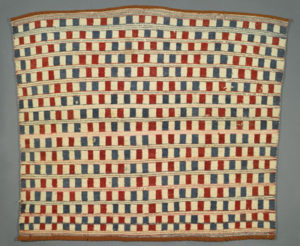 Another piece within the Brooklyn Museum is a blanket dating from the 19th or 20th century. According to the museum, the piece was purchased for $12 from the wife of Chief Billy Sepass at Skowkale First Nation near Chilliwack in 1911. It is made of commercial sheep’s wool and measures 119.4 x 127 cm. The blanket features a bold red, white, and blue check design that repeats throughout the entirety of it. Both the top and bottom edges of the blanket feature a solid red piping as which breaks up the pattern. Although this item is not currently on view, it was featured in the 1991 exhibition “Objects of Myth and Memory.”
Another piece within the Brooklyn Museum is a blanket dating from the 19th or 20th century. According to the museum, the piece was purchased for $12 from the wife of Chief Billy Sepass at Skowkale First Nation near Chilliwack in 1911. It is made of commercial sheep’s wool and measures 119.4 x 127 cm. The blanket features a bold red, white, and blue check design that repeats throughout the entirety of it. Both the top and bottom edges of the blanket feature a solid red piping as which breaks up the pattern. Although this item is not currently on view, it was featured in the 1991 exhibition “Objects of Myth and Memory.”
The extensive number of Coast Salish items at both the AMNH and Brooklyn Museum are showcasing the larger history of the Coast Salish people while also offering a glimpse into how artifacts become part of institutional memory and collections.
Anni Irish is a writer and cultural critic based in Brooklyn, NY.


